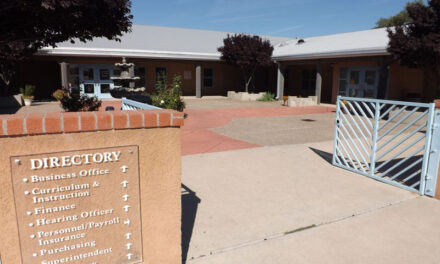The latest feasibility study on a Valencia County health care facility is still in the works, but an update to the county commissioners provided a variety of possible facilities, as well as projected patient use and costs of the project.
Jon Huddy, president of Huddy HealthCare Solutions — the consultant working with Kulik Strategic Advisors Inc., of Dawsonville, Ga. on the study — said his company began collecting data in June.
His company is evaluating information to help determine the feasibility of three different types of facilities in Valencia County — a freestanding emergency department, a destination ambulatory center and a micro-hospital.
A freestanding ED would have the ability to screen patients and determine if they needed to be admitted to a hospital. Such a facility would be licensed under a hospital/health system provider and have observation beds for patients who would be there less than 24 hours.
Huddy estimated a freestanding ED would need four beds, developed at inpatient standards but not licensed as such because an emergency department doesn’t meet the state’s requirements to be a hospital.
The second option — a destination ambulatory center — would contain an ED, as well as additional services such as imaging, a laboratory, therapeutic services and medical offices.
A micro-hospital would have licensed, inpatient beds, as well as additional support and administrative components necessary to meet hospital regulations.
Ann Jones, a Los Lunas resident and member of the Medical Care Advocates of Valencia County group, asked if a freestanding ED would qualify under federal Centers for Medicare and Medicaid Services standards and be able to accept Medicare.
Huddy said the term “freestanding” applied to the physical building only.
“A freestanding emergency department needs to be licensed under a provider, is my understanding,” he said.
One piece of information Huddy looked at was population projections by age in various county zip codes. While the total number of people in the Los Lunas and Belen zip codes are projected to see very little growth by 2025, those 65 and older are projected to increase by 31.4 percent and 18.6 percent, respectively, according to the information Huddy presented.
According to data analyzed by IBM Watson Health projects more than 36,000 emergency department visits annually from county residents by 2030. Types of ED visits are rated on the emergency severity index, with an ESI 1 being the most critical, such as cardiac arrest or massive bleeding, and an ESI 5 visit being for a rash or prescription refill.
Looking at the emergency severity index along side historic ED visit numbers for Valencia County helps indicate who would use a local emergency department and who would bypass such a facility to continue north to Albuquerque. Information presented by Huddy showed the majority of emergency visits nationwide and from Valencia County fall in the ESI 3, 4 and 5 categories.
“Level 1s are most likely going to be raced to a trauma center in Albuquerque. What it came down to, looking at certain percentages and market shares, there would be about 18,000 to 19,000 patients using an emergency department in the county,” he said. “I’ve seen freestanding EDs build for 8,000 to 12,000 patients.”
Huddy said if the a local facility developed a good reputation for quality care, it could serve 18,000 to 21,000 people.
“Looking at gravitational and historical pull, certain people will continue to go to Albuquerque,” he said.
Even then, the average daily bed census for inpatient services to Valencia County residents is just two.
“Some days are higher, some lower, obviously, but the average is two, so the targeted beds needed could be four,” Huddy said. “Admittedly running a hospital with just four beds, you can’t have just one nurse. A lot of our clients look at having eight to 12 beds so they can have two nurses on at a time. Now this is oversimplifying staffing. You could add a speciality, like infectious disease and dedicate five beds to that, so you build to eight beds and develop a facility around a potential future eight beds. We can develop multiple pathways forward to develop interest moving forward.”
Huddy said at this time, they were looking at a facility that could support 18,000 to 21,000 emergency department visits annually, four general medicine beds with a possible expansion to eight beds for a total of about $49.9 million.
In early October, the county commissioners amended the Infrastructure Capital Improvement Plan to add a request for $50 million to plan, design and construct a hospital/24-hour emergency health care facility
Gov. Michelle Lujan Grisham said the facility was one of her top priorities and made a commitment to allocate funding from the billions in federal COVID-support funds that have recently flowed into the state.
Los Lunas resident Del Conroy encouraged the commission, Huddy and KSA to consider future growth for the facility, saying five acres might be good for the initial project but might leave the facility “landlocked” and unable to grow in the future.
He also asked whether the mill levy funds the county collected could be used to help build a facility.
County attorney Dave Pato said the county can only use the mill levy money for operation and maintenance.
The tax was collected from 2007 to 2014 and has amassed more than $26.6 million in an interest-bearing account at Bank of the West.
As a recipient of Medicare, Tom Mraz, of Meadow Lake, said he was told the insurance wouldn’t pay for observation.
“When I’ve have to go to a hospital and been held for observation, the doctor said they would only get paid when I was admitted. (Medicare) won’t pay for anything else,” Mraz said.
Huddy said he wasn’t a reimbursement specialist, adding he hadn’t heard that from his previous clients.
With projections out to 2030, Huddy told the commissioners the numbers would probably be valid for at least five or six years.
“I think they’re pretty dead on. Unless you get some huge corporations that come plop things down and see a huge increase in your population, I think the numbers are good,” he said.
County purchasing agent Rustin Porter said he wasn’t sure when KSA would complete the feasibility report.
Hospital Feasibility Study Update (December 2021)
Julia M. Dendinger began working at the VCNB in 2006. She covers Valencia County government, Belen Consolidated Schools and the village of Bosque Farms. She is a member of the Society of Professional Journalists Rio Grande chapter’s board of directors.


















